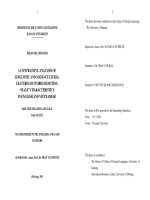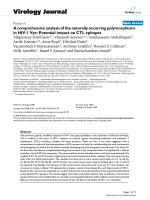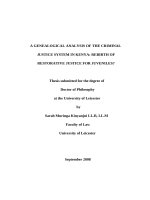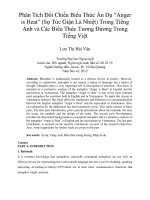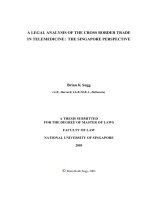A contrastive analysis of the utterances containing implicatures in english and vietnamese culture (based on utterances from funny stories)
Bạn đang xem bản rút gọn của tài liệu. Xem và tải ngay bản đầy đủ của tài liệu tại đây (1022.47 KB, 65 trang )
HANOI OPEN UNIVERSITY
CODE: 26
FACULTY OF ENGLISH
-----
-----
GRADUATION THESIS
B.A DEGREE IN ENGLISH STUDIES
A CONTRASTIVE ANALYSIS OF THE UTTERANCES CONTAINING
IMPLICATURES IN ENGLISH AND VIETNAMESE CULTURE
(Based on Utterances from Funny Stories)
Supervisor
: Nguyen The Hoa, M.A
Student
: Hoang Thi Yen
Date of birth
: 20/11/1994
Course
: K19 (2012-2016)
HANOI, 2016
Graduation Paper
DECLARATION
“A CONTRASTIVE ANALYSIS OF THE UTTERANCES CONTAINING
IMPLICATURES IN ENGLISH AND VIETNAMESE CULTURE”
(Based on utterances from funny stories)
I certify that no part of above report has been copied or reproduced by me
from any other’s work without acknowledgement and that the report is originally
written by me under strict guidance of my supervisor.
Ha Noi, 15thApril, 2016
Student
Supervisor
Hoang Thi Yen
Nguyen The Hoa
Hoang Thi Yen - 1271A06 (2012 - 2016)
Graduation Paper
ACKNOWLEDGEMENT
At this stage of research accomplishments, I would first like to thank my
supervisorMr. Nguyen The Hoa of the Fulculty of English at Hanoi Open
University. He consistently allowed this paper to be my own work, but steered
me in the right the direction whenever he thought I needed it.
I would also like to acknowledge Faculty of English, Hanoi Open
University, all my teachers and the librarians for providing favorable conditions
for my study to be implemented.
Finally, I must express my very profound gratitude to my parents and to
my friends for providing me with unfailing support and continuous
encouragement throughout my years of study and through the process of
researching and writing this thesis. This accomplishment would not have been
possible without them. Thank you.
Hoang Thi Yen - 1271A06 (2012 - 2016)
Graduation Paper
TABLE OF CONTENTS
DECLARATION
ACKNOWLEDGEMENT
TABLE OF CONTENTS
LIST OF ABBREVIATION
LIST OF FIGURES AND TABLES
PART A: INTRODUCTION............................................................................... 1
1. Rationale ...................................................................................................... 1
2. Aims and objectives of the study ............................................................... 3
3. Scope of the study ....................................................................................... 3
4. Research questions...................................................................................... 4
5. Methods of the study .................................................................................. 4
6. Design of the study ...................................................................................... 4
PART B. DEVELOPMENT ................................................................................ 6
CHAPTER I. THEORETICAL BACKGROUND ........................................... 6
1.1. Overview of discourse analysis ............................................................... 6
1.1.1. Definition of discourse ....................................................................... 6
1.1.2. Discourse analysis .............................................................................. 7
1.1.3. Context in discourse analysis............................................................. 9
1.2. Utterance meaning................................................................................. 10
Hoang Thi Yen - 1271A06 (2012 - 2016)
Graduation Paper
1.3. Contrastive analysis............................................................................... 11
1.4. Implicatures ........................................................................................... 12
1.4.1. The notions of implicature ............................................................... 12
1.4.2. Kinds of implicatures........................................................................ 14
1.4.2.1. Conventional implicature............................................................... 14
1.4.2.2. Conversational implicature............................................................ 14
1.4.3. The Cooperative principle ................................................................ 16
1.4.4. Maxims and flouting maxim ............................................................ 17
1.4.4.1. The Maxim of Quantity .................................................................. 17
1.4.4.2. The Maxim of Quality .................................................................... 18
1.4.4.3. The Maxim of Relation ................................................................... 19
1.4.4.4. The Maxim of Manner .................................................................... 19
1.5. Overview of funny stories ..................................................................... 20
1.6. Summary ................................................................................................ 22
CHAPTER II. INTERPRETATION AND ANALYSES ............................... 23
2.1. Funny stories in English........................................................................ 23
2.1.1. Violating the Maxim of Quantity ..................................................... 23
2.1.2. Violating the Maxim of Quality ....................................................... 24
2.1.3. Violating the Maxim of Relation ..................................................... 27
2.1.4. Violating the Maxim of Manner ...................................................... 29
2.2. Funny stories in Vietnamese ................................................................. 32
Hoang Thi Yen - 1271A06 (2012 - 2016)
Graduation Paper
2.2.1. Violating the Maxim of Quantity ..................................................... 32
2.2.2. Violating the Maxim of Quality ....................................................... 34
2.2.3. Violating the Maxim of Relation ..................................................... 38
2.2.4. Violating the Maxim of Manner ...................................................... 39
2.3. Discussion ............................................................................................... 41
2.3.1. The violating of maxims in English and Vietnamese ..................... 41
2.3.2. Similarities between English and Vietnamese implicatures........... 43
2.3.3. Differences between English and Vietnamese implicatures .......... 45
2.3.4. Summary ........................................................................................... 48
CHAPTER III. SUGGESTION SOME STRATEGIES TO TRANSLATE
THE UTTERANCES CONTAINING IMPLICATURES ............................. 49
PART C: CONCLUSION.................................................................................. 52
REFERENCES
Hoang Thi Yen - 1271A06 (2012 - 2016)
Graduation Paper
LIST OF ABBREVIATION
C.A.: Contrastive Analysis
C.I: Conversational Implicature
CP: Cooperative Principle
Hoang Thi Yen - 1271A06 (2012 - 2016)
Graduation Paper
LIST OF FIGURES AND TABLES
Table 1: Result of survey on breaking of maxims in English and Vietnamese
funny stories…………………………………………………………………….41
Chart 1: Result of survey on breaking of maxims in English and Vietnamese
funny stories…………………………………………………………………….42
Hoang Thi Yen - 1271A06 (2012 - 2016)
Graduation Paper
PART A: INTRODUCTION
1. Rationale
Nobody can deny that language plays an important role in human
development. Language is the means to serve the purposes of communication
among people who share the same nationality and social origin. In other words,
language exchanges the human behaviors, “language is closely related to the way
we think and to the way we behave and influence the behaviors of others”
(Karmic 1998, p.79).The relationship between language and culture isa complex
one due largely in part to the great difficulty in understanding people’s cognitive
processes when they communicate.Each of nations has their own language and
culture; therefore, Vietnamese learners of English have to encounter with a
variety of issues in understanding this language. Moreover, along with social
exchanges, the utterances usually contain implicature, making people confused
in the communication. As Geoffrey Leech (1983, p.34) argues “we cannot really
understand the nature of language itself unless we understand pragmatics”. Thus,
melting the theory of pragmatics is the key step to improve the ability of using
language.
Pragmatics deals with the study of language in use in different contexts. It
did not appear as an independent branch of linguistics until 1960s and 1970s. As
a branch of pragmatics, the theory of implicature experienced along history and
can be traced back to relations with Semiotics and the Theory of Deviation.
However, in 1967, the theory ofimplicature was formally suggested by Herbert
Hoang Thi Yen - 1271A06 (2012 - 2016)
1
Graduation Paper
Paul Grice (1913-1988), an English linguistic philosopher. He introduced the
technical notion of implicature in systematizing the phenomenon of meaning one
thing by saying something else. In introducing the notion, Grice drew a line
between what is said, which he understood as being closely related to the
conventional meaning of the words uttered, and what is conversationally
implicated, which can be inferred from the fact that an utterance has been made
in context. Since Grice’s seminal work, implicatures has become one of the
major research areas in pragmatics.In particular, some of the best-known works
include “Presumptive Meanings” (The Theory of Generalized Conversational
Implicature), by Stephen C. Levinson (2000), “Pragmatics” by George Yule
(1996), “Relevance Theory” bySperber & Wilson (1986).
In Vietnamese, a lot of famous linguistic philosophers researched into the
characteristics of implicatures. The popular works belong to Nguyen Duc Dan
(1996), Nguyen Thien Giap (2000), “Tiếng Việt – Mấy vấn đề ngữ âm, ngữ pháp
và ngữ nghĩa” by Cao Xuan Hao (1998).
Building on the theorical background of above linguistic philosophers, in
particular, the writer would find out about the utterances containing implicatures
in English and Vietnamese culture in terms of funny stories. Although there are a
lot of works on this topic, almost of them have not to mention the similarities
and differences between English and Vietnamese implicature yet. Some works
focused on humor mechanism of Vietnamese funny stories, “Cơ chế tạo hàm ý
hội thoại trong truyện cười dân gian Việt Nam” by Pham Minh Luan B.A
Degree (2012), for example.
Hoang Thi Yen - 1271A06 (2012 - 2016)
2
Graduation Paper
Not only be valuable in daily communication, implicature also has great
value in literature. Implicature is used the most in funny stories that not only
bringthe happiness and entertainment for people but also reflect the vice of
society. However, due tothe differences of people, cultureand social issues
between two countries, there are also differences in mechanism making
implicatures from funny stories.
For the above - mentioned related problems, this study is implemented to
provide the background of implicature, help Vietnamese learners understand
deeply messages of funny stories and realize the value of implicatures in the
funny stories.
2. Aims and objectives of the study
The thesis aims at:
• Providing background knowledge of implicatures.
• Comparing and contrasting English and Vietnamese implicatures in terms
of maxims.
• Pointing out the value of implicatures in the funny stories.
3. Scope of the study
Scopeof the study is limited to analyze implicature in some selected
English and Vietnamese funny storiesin terms of Cooperative principal and
maxims.The writer studies on Vietnamese funny stories in“1001 truyện cười dân
gian xưa và nay” (Hung Danh, 2000), and English funny stories in sources from
internet.
Hoang Thi Yen - 1271A06 (2012 - 2016)
3
Graduation Paper
4. Research questions
• What is the role of implicature in English and funny stories?
• What are similariries and differences between English and Vietnamese
implicatures?
5. Methods of the study
• Contrastive analysis
• Collecting available information, statistics from related material and
sourse.
• Surveying English and Vietnamese funny stories
6. Design of the study
The study consists of three parts:
Part A. Introduction
1. Rationale
2. Aims and objectives of the study
3. Scope of the study
4. Research questions
5. Methods of the study
6. Design of the study
Part B: Development. It consists of three chapters:
Chapter 1: Theoretical Background
Chapter 2: Interpretations and analyses
Hoang Thi Yen - 1271A06 (2012 - 2016)
4
Graduation Paper
Chapter 3: Suggestion some strategies to translate the utterances
containing implicatures
Part C: Conclusion
References
Hoang Thi Yen - 1271A06 (2012 - 2016)
5
Graduation Paper
PART B. DEVELOPMENT
CHAPTER I. THEORETICAL BACKGROUND
1.1.
Overview of discourse analysis
1.1.1. Definition of discourse
Since the 1960s of the twentieth century, the discourse analysis has
become a scientific movement thrived in Europe and become a central concept
which is widely circulated in the social sciences and humanities. However,
discourse analysis did not receive much attention from Vietnamese linguists until
the end of the twentieth century.
According to Crystal (1992, p.25) discourse is “a continuous stretch of
(especially spoken) language larger than a sentence, often constituting a
coherent unit, such as a sermon, an argument, joke or narrative”.
Nunan (1993),whocomesfrom amorelinguisticbackground, takes an even
different cut at the definition of discourse. He uses text to refer to the written or
tapedrecord of a communication event and discourse to refer to the interpretation
of that event in the context in which it occurs. According to him, “discourse can
be defined as a stretch of language consisting of several sentences, which are
perceived as being related in some way. Sentences can be related, not only in
terms of the idea they share, but also in terms of the jobs they perform within the
discourse – that is in terms of their functions”.
Hoang Thi Yen - 1271A06 (2012 - 2016)
6
Graduation Paper
“Discourse is language that is functional – language that is doing some job in
some context as opposed to isolated words or sentences. Discourse can be
spoken, written or in any other medium of expression.
Discourse is a unit of language in use. It is not a grammatical unit, like a clause
or a sentence.
Discourse is a semantic unit, a unit not of form but of meaning. A discourse does
not consist of sentences; it is realized by, or encoded in sentences.”
(Halliday M.A.K & Hasan R., 1976)
In general, discourse is defined differently but they have something in
common. Discourse is understood as language in use, which can reflect people’s
point of view and value systems.
1.1.2. Discourse analysis
Discourseanalysis is the systematic study of naturally occurring (not
hypothetical) communication in the broadest sense, at the level of meaning
(rather than as physical acts or features).However, a survey of the literature on
discourse analysis would quickly reveal that, although some researchersemploy
theterm to describe a particular kind of analysis, it is also a label that has
widespread usage acrossseveral disciplines with diverse goals. Consequently,it is
more accurate to think of discourse analysis as a cluster of methods and
approaches with some substantial common interestsrather than as a single,
unitary technique.
Hoang Thi Yen - 1271A06 (2012 - 2016)
7
Graduation Paper
Discourse analysis began in branchesof philosophy,sociology, linguistics,
and literary theory, and it is continuing to develop in additional disciplines such
as anthropology, communication, education, and psychology.One of the most
prominent scholars is Yule (1997, p.139), he states in his study of language that
“In the study of language, some of the most interesting questions arise in
connection with the way language is used, rather than what its components
are…We were, in effect, asking how it is language - users interpret what other
language-users intend to convey. When we carry this investigation further and
ask how it is that we, as language users, make sense of what we read in texts,
understand what speakers mean despite what they say, recognize connected as
opposed to jumbled or incoherent discourse, and successfully take part in that
complex activity called conversation, we are undertaking what is known
discourse analysis”.
ForNunan (1993), what he calls discourse analysis involves language as it
is being used, whereas text analysis is concerned with patterns and regularities
that occur in written language, such as phonemic or grammatical analyses. In
other words, discourse analysis is concerned with patterns and regularities in
language but also with the people using language (what they mean and the
purpose to which language is put) and the context in which it is used.
In short, discourse analysis is a branch of linguistics that deals with the
largest unit of language in communication – discourse or text. It considers the
ways that the use of language presents different views of the world and different
understanding.
Hoang Thi Yen - 1271A06 (2012 - 2016)
8
Graduation Paper
1.1.3. Context in discourse analysis
Context plays a very important role in the interpretation of discourse. As
Nunan (1993, p.7) defines “context refers to the situation giving rise to the
discourse, and within which the discourse is embedded”. In his opinion, there
are two different types of context. The first type is linguistic context which is the
language that surrounds or accompanies the piece of discourse under analysis.
The second one is non-linguistic or experiential context which is the context in
which the discourse takes place. Non-linguistic contexts includethe type of
communicative event (e.g. joke, story, lecture, greeting, conversation); the
topic;the purpose of the event; the setting including location, time of day, season
of year, and physical aspects of the situation, the participants and the
relationships between them; and the background knowledge and assumptions
underlying the communicative event.
Grundy (2000, p.72) states that in the case of implicature, context helps us
to determine what is conveyed implicitly but not explicitly stated by the speaker.
Grundy (2000, p.107) also adds that context is not treated as given common
ground, but rather as a set of more or less accessible items of information which
are stored in short term and encyclopedic memories or manifest in the physical
environment.
Cook (1989, p.10) defines that the context is the unity of discourse
withconsidering the word at large, and it is the influenced by the situation when
we receive the message, cultural and social relationship within the participant,
what we know and assume the sender knows. When we think about meaning, it
is also important to take into account the contribution of context. In simple
Hoang Thi Yen - 1271A06 (2012 - 2016)
9
Graduation Paper
terms, then, we can think about pragmatics as the study of the contribution of
context to meaning.
Utterances are not only dependent on the physical context for their
interpretations, they are also closely related to the language surrounding them
(co-text). Hence, according to Brown and Yule, the more context there is, in
general, the more secure the interpretation is. (1983, p.50)
In summary, context plays a vital role in discourse analysis. Context
makes clear interpretation and is references among words and sentences.
1.2.
Utterance meaning
Utterance meaning is defined as what a speaker means when he makes an
utterance in a certain situation. In other words, utterance meaning is contextdependent and the meaning of an utterance is determined by the context in which
it is used.
According Austin, there are two kinds of utterances: constative and
performative utterance. A performative utterance is one that actually describes
the acts that it performs. It brings about a state of affairs such as bids, blessings,
promising, firings, arrests, complaints, marrying. For instance, “I promise to pay
you tomorrow” is performative because in saying it the speaker actually does
what the utterance describes. In constrast, a constative utterance is one which
makes an assertion, i.e it is often the utterance of a declarative sentence, but is
not performative.
According to Nguyen Thien Giap (2014), the utterance meaning refers to
what the speaker means in a particular context of situation.According to speech
Hoang Thi Yen - 1271A06 (2012 - 2016)
10
Graduation Paper
act theories, every utterance has two types of meaning: propositional meaning
and illocutionary meaning.
In
summary,
aconversational
utterance
is
considered containing
implicatures when it includes:
• The explicit meaning (Literal sense) based on the words in sentence
• The implicit meaning (Figurative sense) based on the concrete context
1.3.
Contrastive analysis
Contrastive analysis (C.A.) dates back to the 1950s when it was first
developed and practiced as an application of structural linguistics to language
teaching. As regards its definition James, C. (1980, p.3) declares:
“Contrastive Analysis is a linguistics enterprise aimed at producing
inverted (i.e. contrastive, not comparative) two-valued typologies (a C.A. is
always concerned with a pair of language), and founded on the assumption that
languages can be compared.”
James also claims that there are three branches of two-valued (two
languages are involved) interlingual linguistics: translation theory – which is
concerned with the process of the text conversion; error analysis; and contrastive
analysis – these last two having as the object of enquiry the means whereby a
monolingual learns to be bilingual. Among these branches of linguistics, C.A.
seems to be the most effective way in comparing between the first language and
the second language as well as a pairs of languages foreign language learners are
learning.
Hoang Thi Yen - 1271A06 (2012 - 2016)
11
Graduation Paper
Contrastive analysis is defined, according to James (1980), as a form of
interlanguage study and a central concern of applied linguistics. As a matter of
fact, C.A. has had much to offer not only to practical language teaching, but also
to translation theory, the description of particular languages, language typology
and the study of language universals. In relation to bilingualism, C.A. is
concerned with how a monolingual becomes bilingual; in other words, it is
concerned with the effects exerted by the first language on the foreign language
being learnt. Thus, C.A has been a preferable method used by Vietnamese
linguists in recent years as it enables them to contrast Vietnamese with other
languages not only of the same typologies, but also of different ones. It also
helps bring out many interesting differences and similarities between languages,
which make a great contribution to lightening the language teaching and learning
burden.
1.4.
Implicatures
1.4.1. The notions of implicature
The notion of implicature was first introduced by Grice (1967), who
defined it essentially as what is communicated less what is said. A. Davis (1998)
defines implicature is Grice’s term for what a speaker does not say but rather
communicates, suggests, implies, in virtue of saying what he does. It also refers
to the fact of something’s being so communicated.An implicature, on the other
hand, is defined as “any other propositional form communicated by an
utterance; its content consists of wholly pragmatically inferred matter” (Carston
2000, p.10). This definition of implicature follows from Sperber and Wilson’s
original assumption that any assumption communicated which is not explicit
Hoang Thi Yen - 1271A06 (2012 - 2016)
12
Graduation Paper
must be implicit, and thus must be an implicature (Sperber and Wilson 1995,
p.182).
Levinson(1981, p.98) adds the notion of implicature promises to bring the
gap between what is literally said and what is actually said. Yule (1996, p.36)
adds that implicature is a primary example of more being communicated than is
said but in order for them to be interpreted, some basic cooperative principle
must first be assumed to be in operation. Furthermore, Grice as quoted by
Levinson (1992, p.97) explains that the term of implicature to be a general cover
term to stand in contrast to what is said or expressed by the truth condition of
expression, and to include all kinds of pragmatics.
In Vietnamese pragmatics, some Vietnamese linguists mentioned the
notion of implicature on their works or books. Cao Xuan Hao (1995) considered
that a sentence includes two meaning: propositional meaning and illocutionary
meaning. In his opinion, “We can see that there are two different parts basing on
“content” or “meaning”. A part occurs on sentence by itself (propositional
meaning) separating from all of the events, the other brings another meaning
(illocutionary meaning) when it is used in a particular event.” The notion of
propositional and illocutionary meaning of Cao Xuan Hao is quite similar with
the notion of explicature and implicature of Nguyen Duc Dan (1998). The
illocutionary meanings/ implicaturesare supposed the meaning of speech.
Grice
divides
implicature
into
conventional
implicature
and
nonconventional implicature (conversational implicature).In this research, the
writer only focuses on conversational implicature because the utterances in
Hoang Thi Yen - 1271A06 (2012 - 2016)
13
Graduation Paper
funny stories are calculated by maxims of conversation which means they
depend on the recognizing the cooperative principle.
1.4.2. Kinds of implicatures
1.4.2.1. Conventional implicature
The conventional implicature has the same implication no matter what the
context is.It means that it does not have to occur in conversation, and they do not
depend on specialcontexts for their interpretation. The conventional implicature
is presented less explicit compared with entailment, presupposition and
conversational implicature. Grice (Logic and Conversation, 1975) said briefly
about conventional implicature that is “the use of a certain form of words in an
utterance would normally (in the absence of special circumstances) carry suchand-such an implicature or type of implicature”.
1.4.2.2. Conversational implicature
Conversational implicature (C.I) is a type of indirectcommunication, first
described by the English language philosopherH. P. Grice. He proposes that in a
normal conversation, speakers and listeners share a cooperative principle.
Sperber & Wilson’s Relevance Theory (1986, p.28) could be regarded as
an attempt to develop Grice’s basic insight. Their aim is to characterize a
property of mental process which the ordinary notion of relevance approximates.
“Conversational implicaturesare not tied to linguistic form. To make a
C.I, a listener must have already parsed the sentence, assigned it its literal
interpretation, realized that additional inferences must be added to make it
Hoang Thi Yen - 1271A06 (2012 - 2016)
14
Graduation Paper
conform to the Griceanmaxim, and determined what these inferences are. Such
activity could not reasonably affect the initial steps of parsing.”
(Clifton & Ferreira, 1989)
Nguyen Thien Giap (2000) says that in conversation, to understand what
the speaker wants to communicate, the listener must be aware of not only the
explicit meaning drawn from the literal meaning of the words and the structures
of the utterance, but the implicit meaning inferred from what is said.
Related to conversational implicature and its reasons, Cao Xuan Hao
raised a question why people avoid saying explicitly or indicating literal meaning
instead of saying implicitly, which sometimes challenges the hearers. He showed
that conversational implicatures were produced because of the complicated
requirements of social communication, of the interaction in community, of the
distinctive culture and of the trends towards the beauty.
Grice (1975, p.26) states C.I is triggered by “certain general features of
discourse” rather than by the conventional meaning of a specific word.
Grice
introduces
conversationalimplicature:
a
distinction
Generalized
between
Implicature
two
and
types
of
Particularized
Implicatures.
Generalized Implicature
Grice as quoted by Levinson (1992, p.126) distinguished conversational
implicature into generalized and particularized implicature. He asserts that
Hoang Thi Yen - 1271A06 (2012 - 2016)
15
Graduation Paper
generalized conversational implicature is implicature that arise without any
particular context or special scenario being necessary.
Levinson (1983, p.126) defines Generalized conversational implicatures
occur without reference to any particular features of the context. In other words,
special background knowledge or inferences are not required in calculating the
additional conveyed meaning. Grice (1989, p.37) states this type of implicature
is characterized by, “the application of a certain form of words in an utterance
(in the absence of special circumstances) would normally carry such
implicature”.
Particularized Implicature
A particularized conversational implicature is one which depends on
particular features of the context. Lakoff (1993, p.107) defines particularized
implicature is implicature that needs context or cultural understanding must be
assumed. Particularized implicature is a conversational implicature that is
derivable only in a specific context.
1.4.3. The Cooperative principle
The success of conversation depends on the various speakers approach to
the interaction. In order to explain how hearers interpret the utterance
implicature, Grice introduced the Cooperative Principle (CP). The CP is a basic
underlying assumption we make when we speak to one another is that we are
trying to cooperate with one another to construct meaningful conversations.
Grice (1975) proposes the CP which states “make your conversational
contribution such is required, as the stage at which it occurs by the accepted
Hoang Thi Yen - 1271A06 (2012 - 2016)
16
Graduation Paper
purpose or the direction of the talk exchange which you are engaged”. In other
words, we as the speakers should contribute meaningful, productive utterance to
further the conversation. It then follows that, as listeners we assume that our
conversational partners are doing the same.
According to the CP, both speaker and hearer converse with the
willingness to deliver and interpret a message. The speaker and hearer cooperate
and that is why they communicate efficiently. In order to illustrate how we
interpret, Grice presented four conversational maxims, to show how we
communicate effectively in the light of rules.
1.4.4. Maxims and flouting maxim
If one of the maxims is violated by some utterances and yet we are still
assuming that person is cooperating with us in communication, we can take that
violation as sign that something being said indirectly. This is called flouting
maxim. Flouting is deliberate and apparent violation of maxim. Grundy (2000,
p.78) states that flouting maxims particularly are salient way of getting an
addressee to draw an inference and hence recover an implicature.
1.4.4.1. The Maxim of Quantity
1. Make your contribution as informative as is required (for the current purposes
of the exchange)
2. Do not make your contribution more informative than is required.
Flouting the second Maxim of Quantity:
Hoang Thi Yen - 1271A06 (2012 - 2016)
17


